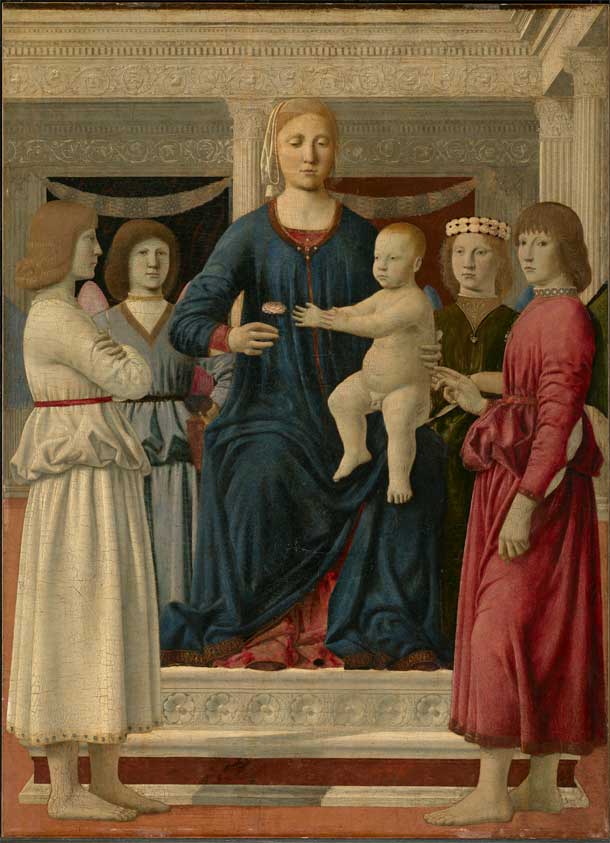Piero della Francesca at The Frick

Piero della Francesca | Virgin and Child Enthroned with Four Angels (1480-1482)
Williamstown, Sterling and Francine Clark Art Institute
Information wants to be free, as they say, but not all that free. That’s a credo and caveat for anyone who borrows content on the Internet and establishes attribution with a link. Outright plagiarism, though, is another thing, isn’t it? On the other hand, The Wasteland contained large appropriations of words which were a few centuries overdue from the library. Eliot once said, Good writers borrow; great writers steal outright. But he was an honest thief, and his footnotes were as funny and interesting and cool as the poem itself. Five centuries ago, Piero della Francesca left quite a bit of work unfinished and unsigned at his death, which meant, according to Vasari, that the parasitic Fra Luca del Borgo finished and claimed it as his own, as if he were Salieri trying to exact some glory, long in arrears, from Mozart. In Vasari’s book, Luca steals credit for Piero’s work and in the words of Vasari, he acted like those who “cover their own ass’s hide with the noble skin of a lion.” (OK, full stop. Have I actually stumbled onto the derivation of this phrase? Did “covering your ass” become public, as it were, with Vasari? If so, I hereby bequeath my accidental discovery to the editors of the Oxford English Dictionary. I’m not about to pay the annual subscription of hundreds of dollars just to see if they trace the phrase back to Vasari or thereabouts, but knock yourselves out guys.) So apparently poor Piero suffered by losing authorship of his own original work. Let’s put Richard Prince aside and imagine, in our own time, a mere work-for-hire craftsman who actually puts his own brand on a Koons or Hirst who, after the untimely death of said artists, “finished” the work and claimed it as his own. But what would be the point? Money is what they’re up to, so the studio worker would be better off if he forged a Koons signature, but claimed ownership, not authorship. So apparently, some things do improve over time in the world of art, if only incrementally.
But wait. As I read on, it turns out all of this posthumous plagiarism wasn’t about painting. Vasari saves this crucial detail for end of his second paragraph. He had been writing about Piero della Francesca’s work under the influence of Euclid. It was about his . . . books. If Vasari is to be trusted, Piero was as much a highly respected mathematician as he was a painter. He wrote many volumes, Vasari says, on geometry, but being, apparently, the genius that he was, he didn’t finish anything but was too A.D.D. to tie up the loose ends, constantly essaying into new regions, maybe figuring he’d get back to his calculations and diagrams eventually. But he didn’t. He left it to the scavenger, Luca, to do all that and then put his name on all of it. He took Jay Mohr’s advice, Put your name on it!, but in a slightly different sense.
Third paragraph in, we finally learn that Piero actually did some painting, apparently in his spare time. “Besides excelling in the sciences, he also excelled in painting.” Also. He also was an excellent painter, when he could get around to it. Well, yeah. At Painting Perceptions, Xico Greenwald writes that Aldous Huxley, called Peiro’s Resurrection in Sansepolcro “the greatest painting in the world.” For a few more pages, Vasari gives the man his due, but it isn’t clear he thinks as highly as he might have about a fellow who couldn’t stick to his knitting and maybe should have finished elucidating the cube, sphere and cone before he tried to show you how a round bald head, say, would look under a Northern Italian exposure.
So, on the subject of spheres and cubes, it came as less of a surprise that, after learning that Piero was a geometer, it appears he might have been the first Cubist. (We’re speaking about a painter who died before 1500.) On the second page of Vasari’s brief bio, you’ll find this description of a drawing he did, which enables the author to glide effortlessly from mathematics to art: “Nevertheless some of his writings on geometry and perspective have been preserved . . . and they show him to be inferior to no one in his own times, or perhaps in any other time as well, as do all his works which are full of perspective, most especially a vase drawn in squares and facets so that the front, back, sides, bottom, and mouth are visible; it is certainly a stupendous work . . . “ I do wish this drawing were also on view at The Frick, where Piero della Francesca is being marvelously represented right now by a rare exhibit of only seven paintings—which I intend to see today on my trek across the city working my way from Delancey St. to the Metropolitan. I’m dying to see this drawing because as much as I’d love to witness a prefiguration of the early 20th century—move over, El Greco—I suspect it’s more of an orthographic projection than a Cubist fusion of multiple perspectives. I wonder, though. And I wonder if it survives.
More to come, maybe, and maybe not, on Piero, once I’ve seen the paintings. None other than Mr. Schjeldahl has already done a far better job than I could on a painter who nearly inspired him to quit scooting all over Italy on a Vespa and become a monk back in his young, wanderjahr-ing days. If you have to subscribe to The New Yorker to read his response to the exhibit, it’s worth it. (You’ll get all his other ones too.) Sorry, OED, but I subscribe only to the essential things that I can actually afford . . .
Comments are currently closed.